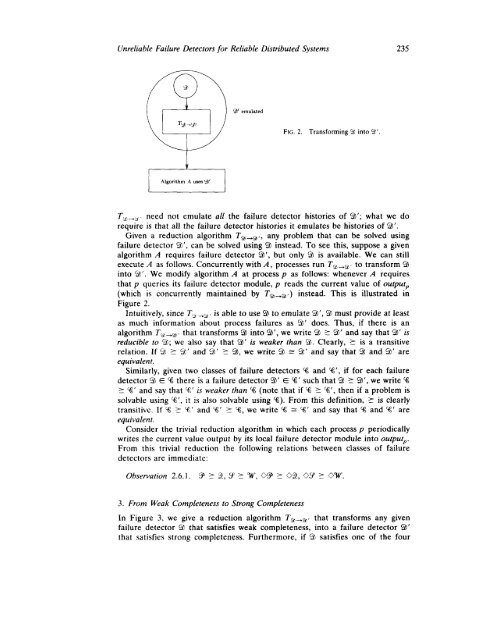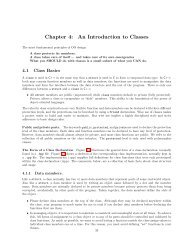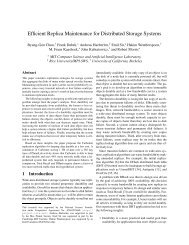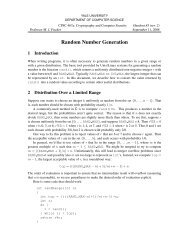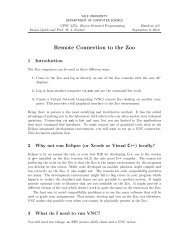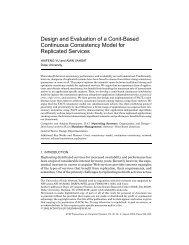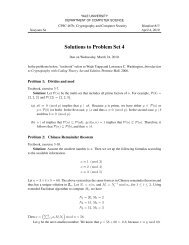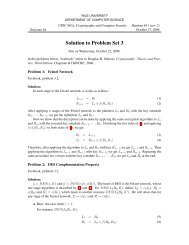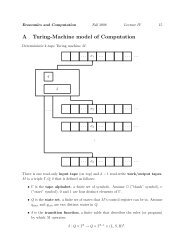234 T. D. CHANDRAAND S. TOUEGFIG. 1.AccuracyCompleteness Strong Weak EventualStrong EventuaIWeakStrong Perfect Strung Eventuoilp Perfect Eventuall~ Strvng9 Y 09 Oy’Weak Wenk EventuaU~ Weak9 w 02 OwEight classes of failure detectors defined in terms of accuracy and completeness.definitions of algorithms and runs, based on the <strong>for</strong>mal definitions given inChandra et al. [19921.11An algorithm A is a collection of n deterministic automata, one <strong>for</strong> eachprocess in the system. Computation proceeds in steps of A. In each step, aprocess (1) may receive a message that was sent to it, (2) queries its failuredetector module, (3) undergoes a state transition, and (4) may send a message toa single process. 12Since we model asynchronous systems, messages may experiencearbitrary (but finite) delays. Furthermore, there is no bound on relativeprocess speeds.A run of algorithm A using a failure detector QJis a tuple R = (F, Ha, I, S, T)where F is a failure pattern, HQ G ~(F) is a history of failure detector ~ <strong>for</strong>failure pattern F, 1 is an initial configuration of A, S is an infinite sequence ofsteps of A, and T is a list of increasing time values indicating when each step inS occurred. A run must satisfy certain well-<strong>for</strong>medness and fairness properties.In particular, (1) a process cannot take a step after it crashes, (2) when a processtakes a step and queries its failure detector module, it gets the current valueoutput by its local failure detector module, and (3) every process that is correctin F takes an infinite number of steps in S and eventually receives every messagesent to it.In<strong>for</strong>mally, a problem P is defined by a set of properties that runs must satisfy.An algorithm A solves a problem P using a failure detector ~ if all the runs of Ausing $3 satisfy the properties required by P. Let % be a class of failure detectors.Algorithm A solves problem P using % if <strong>for</strong> all !2dE %, A solves P using !3.Finally, we say that problem P can be solved using% if <strong>for</strong> all failure detectors 9c & there is an algorithm A that solves P using Q.We use the following notation. Let v be a variable in algorithm A. We denoteby UPprocess p’s copy of v. The history of v in run R is denoted by ~, that is,#(p, t) is the value of VPat time t in run R. We denote by 3P process p’s localfailure detector module. Thus, the value of !21Pat time t in run R = (F, H%, 1, S, T)is HQ(p, t).2.6. REDUCIBILITY. We now define what it means <strong>for</strong> an algorithm TQ -Q, totrans<strong>for</strong>m a failure detector Q into another failure detector $3’ (T9+Q, is calleda reduction algotidtm). Algorithm Ta +9, uses ~ to maintain a variable outputp atevery process p. This variable, which is part of the local state of p, emulates theoutput of Q‘ at p. Algorithm TQ -Q, trans<strong>for</strong>ms !23into Qil’if and only if <strong>for</strong> everyrun R = (F, HQ, 1, S, T) of TQ+Q, using S3, outpu~ E $3’(F). Note thatII Forma] definitions are necessag in Chandra et al. [1992] to Provea subtlelowerbound.12Chandraet al. [1992]assumethat eaclrstep is atomic, that is, indivisible with reSpeCtto failures.Furthermore, each process can send a message to all processes during such a step. These assumptionswere made to strengthen the lower bound result of Chandra et al, [1992].
<strong>Unreliable</strong> <strong>Failure</strong> <strong>Detectors</strong> <strong>for</strong> Re[iabIe <strong>Distributed</strong> <strong>Systems</strong> 2353’ emulatedFIG,2. Trans<strong>for</strong>ming 9 into 9‘,T%,+i, need not emulate all the failure detector histories of q‘; what we dorequire is that all the failure detector histories it emulates be histories of 23’.Given a reduction algorithm Tg~9,, any problem that can be solved usingfailure detector Q‘, can be solved using !JI instead. To see this, suppose a givenalgorithm A requires failure detector Q‘, but only 9 is available. We can stillexecute A as follows. Concurrently with A, processes run Tg, +a, to trans<strong>for</strong>m ~into ~’. We modify algorithm A at process p as follows: whenever A requiresthat p queries its failure detector module, p reads the current value of outputP(which is concurrently maintained by Ta+q, ) instead. This is illustrated inFigure 2.Intuitively, since TQ +9 is able to use !23to emulate !3’, 9 must provide at leastas much in<strong>for</strong>mation about process failures as ‘3’ does. Thus, if there is analgorithm Ty, +q, that trans<strong>for</strong>ms $3 into 9‘, we write $3 Z 93’ and say that Q‘ isreducible to ‘3; we also say that Qb’is weaker than 9. Clearly, 5 is a transitiverelation. If $2 Z !3’ and 9’ 5 $3, we write !’3 = 9‘ and say that $2 and $3’ areequivalent.Similarly, given two classes of failure detectors % and %‘, if <strong>for</strong> each failuredetector ’53G % there is a failure detector ‘3’ E %’ such that Q 553’, we write %> ‘%’and say that %’ is weaker than % (note that if Yi 5 %’, then if a problem issolvable using %‘, it is also solvable using %). From this definition, 2 is clearlytransitive. If % > %’ and %‘ > %, we write % - %‘ and say that % and %’ areequivalent.Consider the trivial reduction algorithm in which each process p periodicallywrites the current value output by its local failure detector module into outputP.From this trivial reduction the following relations between classes of failuredetectors are immediate:3. From Weak Completeness to Strong CompletenessIn Figure 3, we give a reduction algorithm T9 +9, that trans<strong>for</strong>ms any givenfailure detector $7 that satisfies weak completeness, into a failure detector !21’that satisfies strong completeness. Furthermore, if !2 satisfies one of the four


